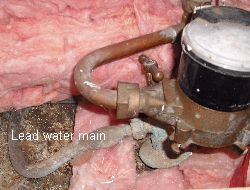| WARNING. Pregnant or possibly pregnant women should never strip paint or be exposed to dust or fumes from paint removal. |
|
| WARNING. Lead water mains are a health hazard and, where possible, should be replaced. Some 'whole house' or under the kitchen counter water treatment systems will remove lead from the water. |
|
Lead in solder
The copper supply lines in newer homes may be joined with a solder which contains lead. Very small amounts of lead still get in the drinking water for the first few years after the house is built. After that, a coating of minerals builds up inside the pipe preventing lead from entering the water. |
Other sources of lead
- Ceramic pottery with lead-based glazes. Lead may get into food served in these dishes if they are badly worn or if the food is acidic.
- Lead crystal. Use lead crystal only for serving. |
|
.
.
.
|
| Lead
|
|
| . |
Need more information? Use our search box
Replace lead water main. Lead in paint. Lead in solder. Lead in pottery. Lead in crystal. Lead poisening.
WHAT ARE THE EFFECTS OF LEAD ON HEALTH?
It has been known for a long time that large amounts of lead can cause serious illness or even death. However, we now know that over a long period of time, exposure to even low levels of lead can effect the development of a child's brain and nervous system.
Symptoms associated with lead poisoning may include insomnia, irritability, poor attention span, loss of memory, headaches, stomach cramps and (at very high doses) damage to the brain and kidneys.
Lead may also impair male fertility and increase the chances of complications during pregnancy.
LEAD EXPOSURE FROM OLD PAINT
Until shortly after World War II, lead was used as a pigments in many paints. Some paints contained as much as 50% lead by weight. Other chemicals gradually replaced lead as sealants, dryers or pigments.
|

Lead water main
|
In the late 1970s new government regulations limited the amount of lead in paint to 0.5% by weight. The dust from crumbling old paint containing lead can get onto children's hands and toys, and from there into their mouths.
Sanding or scraping paint, which contains lead, can produce large amounts of dust which contains lead. Also, friction from opening and closing doors or windows with painted frames can produce dust which contains lead.
REMEDIAL ACTION. The best way to deal with paint that contains lead is often just to leave it alone. If you try to remove it you may create a problem that was not there before. However, if the paint is deteriorating or accessible young children (on a window ledge for example), you should do something about it.
There are three possible solutions:
1. Encapsulation. This means covering the old paint. repainting is not always adequate. Walls may also be covered with wallpaper, drywall or panelling.
2. Replacement. doors, windows, mouldings, baseboards and other trim can be removed and replaced.
3. Paint removal. Paint removal or stripping is potentially the most dangerous way to deal with paint which contains lead. Heat, sanding or sandblasting should NEVER be be used to remove paint which contains lead.
Chemical strippers are preferable. However, these strippers may contain other dangerous chemicals. Strict safety precautions are required and you may want to leave the job to a professional.
LEAD EXPOSURE FROM OLD LEAD PIPING AND SOLDER
Although municipally treated drinking water is virtually lead free when it leaves the plant, it may pick up lead from the plumbing systems serving individual homes. The plumbing system inside houses built before the 1950s may consists partly of lead.
Lead water main When the soft metal is scratched, it shows a bright silver colour. Lead pipes can also be identified by a large ball type connection at the joints. Hot water picks up more lead than cold, so don't use water from the hot tap for drinking, cooking or making baby formula. Even today there are still plenty of homes with a lead water main, especially in older communities.
|
|
|
|
|